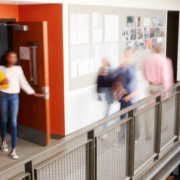How to boost onsite and offsite learning
Connectivity plays a significant role in a school’s ability to boost onsite and offsite learning for its students. There was a time when accessing personal devices and a reliable internet connection wasn’t needed to enhance education. The recent pandemic has helped shine a light on what most school technology professionals have known for some time: effective 21st-century learning requires connectivity.
As schools struggled to get devices in students’ hands and ensure continuity of digital learning, reliable connectivity was at the heart of every plan they devised. Every new device a school adds to its network strains its performance. Even if schools do not have any current issues, it is just a matter of time before problems arise. Preparing for the inevitable is the most effective way to increase connectivity for onsite and offsite learning. Here’s how.
The importance of wireless connectivity
Access to technology impacts the way teachers instruct, and students learn. E-rate funding for schools ensures teachers and students have the resources necessary to increase connectivity both inside and outside the classroom at a reduced cost. Reliable Wi-Fi affords schools and their students many advantages. Here are just a few:
- Easier collaboration. When students and teachers have access to Wi-Fi, they can share documents and edit group presentations in real-time. Collaborating with peers from other schools – even in other countries – is all made easier with reliable Wi-Fi.
- Extended learning. Learning should not be limited to the classroom alone. When students have access to personal devices and schoolwide Wi-Fi, they can explore audio, text, and video content not included in their textbooks.
- Personalized instruction. Differentiation is easier when teachers can tailor lessons for students using online resources.
Why each classroom needs its own access point
To ensure reliable connectivity, every classroom must have its own access point. One of the most common reasons for poor Wi-Fi performance is not enough access points within a building. Having an access point in every classroom provides improved mobility and increased flexibility for security surveillance and monitoring options.
How to determine your school’s baseline
Knowing your baseline is one of the most valuable tools in a school’s connectivity toolkit. Before school technology departments can design an access strategy, they must first consider the number of devices that are connected to their networks at a given time. One of the best ways to accomplish this is with a survey of students and families. From there, an IT provider, like TFE, will perform the survey and use the data gathered to generate reports that show signal strength, coverage areas, and possible interference issues. This will determine what steps need to be taken to remedy the trouble areas. These reports and recommendations will help schools plan accordingly for the increase of devices in classrooms.
Building strong connections
Working with the connectivity experts at TFE is the most effective way to expand your school’s onsite and offsite learning opportunities. We have strong connections to the best-in-class wireless providers and pass along those benefits to our school clients. Our team ensures schools have the best wireless solutions and hardware available to suit their budgets. Contact us to schedule a no-obligation consultation to learn where your school’s connectivity stands.










